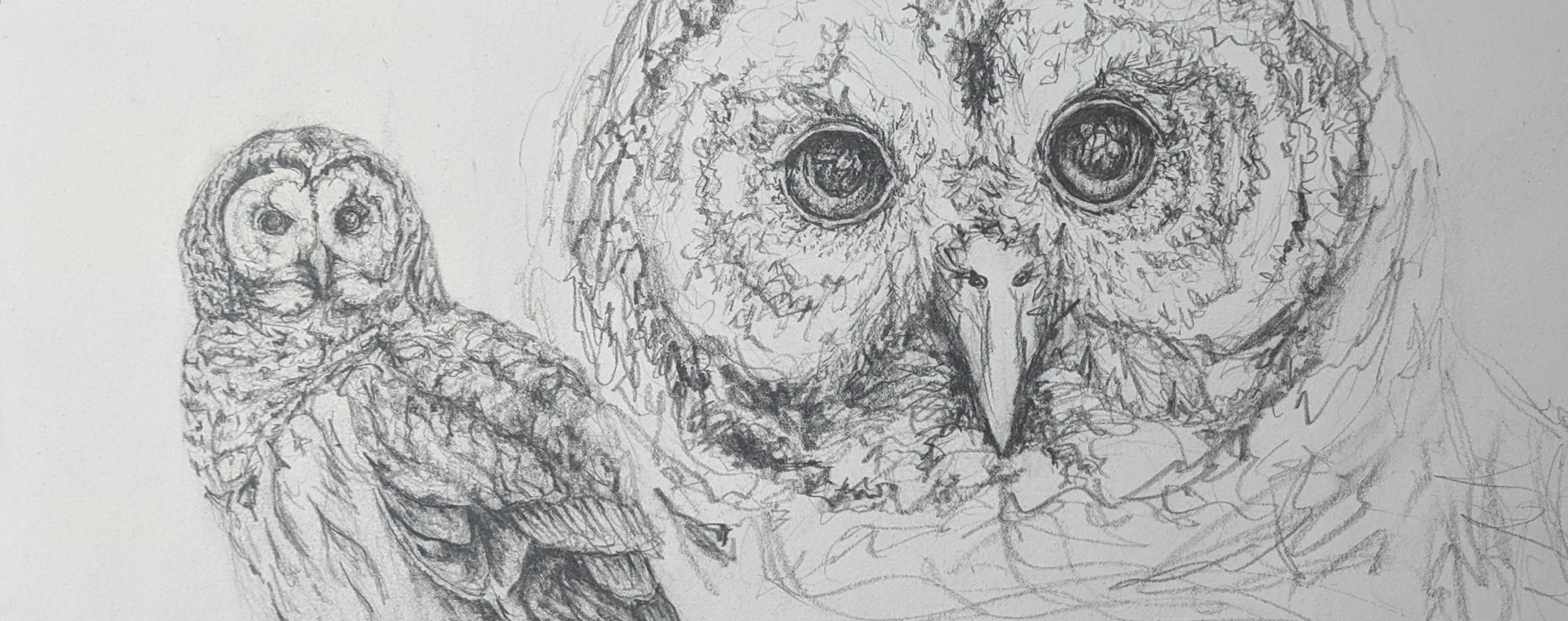Barred Owl Inspirations
Dear Readers,
On a warm, early morning in late January, I embarked on one of my typical runs on one of my typical routes. The sky was a pale grey as I propelled myself up the mountain and through the trees. Seeing something big and feathered take flight from alongside the road made me break out of my ‘early run daydreaming’ state.
At first, I thought it was a hawk. I figured it was probably eating its breakfast before I disturbed it. But, as I watched its wide wings expand, and the massive bird take perch on a tree branch, I realized that its head was much too big and rotund to be a hawk. And then… the realization hit me… it was an owl!
I stopped running.
I had never, ever seen an owl in the wild before. At nature festivals with bird people, sure. But they were tethered and typically sitting on someone’s arm. This was the first time I had ever seen an owl just doing what I guess owls do. I was in absolute awe of how steady, majestic, and BIG the owl was. It was brown and black, and blended in so incredibly well with the forest. The only way I was able to keep my eyes on it, was by locking in on the owl’s big, black, eyes~which were narrowing, and locking in on me.
I started to run backwards up the mountain, never breaking eye contact with the great owl. I wanted to see if their heads really could turn all the way around their body. It did. The owl watched me go up the mountain until I started to round a corner. Then, I turned my body and proceeded on my run, leaving the great owl with the black eyes to do whatever great owls with black eyes tend to do on early mornings in late January.
Of course, when I returned home, I had to do some research (and call William to tell him of my adventure). I learned that the owl was a Barred Owl- the one whose hoots sound like ‘who cooks for you, who cooks for you.’ Which was a fun revelation, because I remember hearing those hoots outside my bedroom window at night so many times… and now I have witnessed the culprit!
According to The Cornell Lab of Ornithology, the Barred Owl tends to live in old, large, untouched forests. Barred Owls use big, dead trees as nesting sites, and they like to roost in tree cavities during the day. Due to the Barred Owl’s dependability on old forests, they are sensitive to logging. The massive bird with big, black eyes, is also, as a result, considered an “indicator species” for how old forests are being managed.¹
This realization caused me to sadly ponder some of the current deforestation I know to be occurring right in my local area. The destruction of old, but still growing, trees is sad in its own right. The disruption of the home for a species of bird that does not like to leave a six mile radius of its home, is disheartening on yet another level.
We continue to therefore face the conflict of using wood to build our home. We wish to use Cross Laminated Timber (CLT) to build The Seed. CLT uses a lot of wood… and wood is a renewable resource… wood is a natural resource… but will it be harvested sustainably? What does ‘sustainably’ mean to some companies? How can William and I ensure that the CLT we use did not impact habitats or negatively affect natural soils? Much more research needs to be done.
Through it all, I would like to keep the Barred Owl in mind and heart as William and I grow with The Seed.
Sincerely,
Shelby Aldrich
Barred Owl Sketch, Artist: Carolyn S. Pio
1. The Cornell Lab of Ornithology. “Barred Owl- Life History,” 2019. https://www.allaboutbirds.org/guide/Barred_Owl/lifehistory. Accessed on 1 Feb. 2020.
© 2020 Sustaining Tree
© 2020 Sustaining Tree


0 Comments